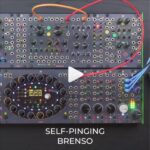We often hear expressions like “filter pinging” to describe a particular snappy and percussive sound that we can obtain on our modular synthesizer.
However, sometimes such sounds can imply two very different ways to achieve them. Both require a trigger impulse, but the first one uses it to generate a modulation signal, while the other uses it to make a filter resonate.
Let’s see more in detail what does ping mean and how to ping a filter!
Technique 1: The “Lowpass Gate” Vibe.
Let us start by quoting Chris Meyer’s words:
In modular synthesis, a “ping” input is a place where you can patch a trigger or gate of any duration, and it converts it into a simple envelope. In particular, some filters and low pass gates (LPGs) have Ping inputs that create an instant attack and fairly quick decay to form a percussive-style envelope, internally patched [to] the filter’s cutoff frequency. If the filter is oscillating due to high resonance, this creates simple analog percussion sounds such as classic drum machine kicks.
Source: Learning Modular.
Through this definition, we can learn that in this technique we use the trigger in the modulation path to generate a ‘simple envelope,’ either through an envelope circuit (like an integrator) or through the natural, nonlinear decay curve of a vactrol-based lowpass gate (LPG).
In this context, the control signal is often used to dynamically change the timbre of a sound by quickly brightening and gradually darkening it while reducing its amplitude, like most “acoustic” percussive sounds do when we pluck or strike a vibrating body.
The lowpass gates developed by Don Buchla in the 70s controlled the VCA and the VCF simultaneously with slightly different curves. Since the Vactrol photoresistors reacted quite fast to triggers but took some more time to return to a lower voltage, they could create a very organic decay. Other pingable circuits do not use vactrols, so they generate envelopes with fast attack times and slower, nonlinear decay curves.
Some Eurorack manufacturers use different names for trigger inputs that do this function, for example, the “Strike” input of Makenoise’s DPO, while others stick to the “ping” label, like with 4MS’ PEG, WMD MMF, or our BRENSO and CUNSA.
In BRENSO’s wavefolder, for example, any rising voltage patched to the Ping input will shoot the wavefolder beyond its highest level and bring it down to the knob’s value with a custom-designed decay. We can change the decay time by turning a dedicated knob, and if we set the wavefolder knob fully counterclockwise, we can “close” it and achieve perfect silence between one ping and the other.
CUNSA also features a ping circuit, but it is quite different. It’s DC coupled and sensitive to the voltage level. If we feed it with a trigger, we will obtain the same behavior as the BRENSO, but if we use other voltages we will experience different behaviors accordingly.
With a gate, for example, the CUNSA will open the filter and hold it open as long as the gate stays high; then, it will close it as the gate goes low, integrating it with an organic decay curve.
It can be thought of as a nonlinear slew limiter that integrates only the falling stage. S&H signals, LFOs, and envelopes will all have a longer transition from a high voltage to a low one.
To sum up the Ping differences between BRENSO and CUNSA, we can say that BRENSO has a circuit that detects only a rising pulse and generates an immediate decaying envelope with fixed amplitude and fixed length defined by the knob; CUNSA, on the other hand, has a circuit that integrates any high-to-low voltage transition and retains every voltage information: duration, magnitude, and trajectory.
BRENSO’s Ping target is a wavefolder that can close completely down to zero, while CUNSA controls the cutoff frequency, so it may have different behaviors according to the filter topology we are monitoring. A lowpass filter will brighten the sound and then darken it; a highpass filter, on the other hand, will slim the sound up to its higher overtones and then open the low-end back.
CUNSA also features a separate filter behavior called Combo mode, in which every control over the cutoff frequency will act simultaneously over the input VCA, including, of course, the Ping circuit.
This behavior progressively reduces a signal’s amplitude once the cutoff frequency gets below a certain threshold.
When we control a lowpass filter through the Ping circuit in combo mode, we will obtain an envelope that attenuates timbre and amplitude with different curves to provide an organic interaction between timbre and volume in lowpass mode.
The combo mode can have other applications that may provide some nice and unexpected tones, on which we’ll dive more in the future.
But yes, to come back to the more general topic, the first “Ping meaning” we are checking is a technique that uses a trig to generate a nonlinear decay curve that usually increases and decreases the harmonic content and the amplitude of a sound at the same time.
If the ping controls a resonant filter, we can set it to self-oscillation and use the png envelope to create a fast sine sweep that might resemble a vintage analog kick. This is possible on the CUNSA, and since it also tracks V/oct, we can use it to modulate our kick drum pitch in an 808 fashion.
Let us now move on to the second technique.
Technique 2: The Resonant Filter Vibe
For this second filter pinging technique we need resonant filters and no audio signals at all.
We need to set our filter right below the self-oscillation point and adjust the cutoff frequency to taste: the crucial thing is that it must produce an audible and pleasant sine wave when set to self-oscillation.
Then, we will patch a trigger signal straight to the filter’s audio input. The abrupt voltage spike will cause the filter to quickly self-oscillate, only to return to silence after a more or less prolonged decay according to the filter design.
This technique is often called Pinging as well, but another term is ringing, which we can find in Allen Strange, page 152:
One of the more interesting applications of this type of filter is called “filter ringing.” By patching a sharp transient, such as a keyboard trigger, to the filter input, the circuit will ring at the specified cutoff frequency. You can try this by patching the trigger output of the keyboard to the signal input of the filter. Increase the Q so that an activated trigger produces a decaying sound from the filter. Note that the decay time can be adjusted by raising and lowering the Q value.
With this technique, therefore, we are not modulating the cutoff frequency and we are not even using the filters to process a sound. Instead, the filter becomes our voice. If the filter tracks V/oct, we can use these signals to change the note of our resonant pluck. In our experience, lowpass and bandpass are the most suitable filters, but you can experiment with other topologies.
While the first technique we saw was peculiar to Buchla systems, this one is practically impossible in that world due to the Buchla convention of keeping audio and modulations separate, with distinct cables and connectors.
To ring CUNSA you must also consider the Character parameter and the input VCA level, but despite those extra controls, the result is very crystalline and consistent. Since CUNSA is a quadruple filter, we can set all four filters to the same VCA, Q, and Character settings, but with four different cutoff frequencies. This would create a very woody, almost marimba-like sound.
To sum up, the two techniques’ only similarity is the use of trigger signals to create percussive sounds with a sharp attack and a longer decay. Everything else is completely different. For this reason, even if sometimes they might be called in the same way, we prefer to name technique 1 “pinging” and technique 2 “ringing,” following Allen Stranges’ convention. Still, the takeaway is that with CUNSA you can do both!





